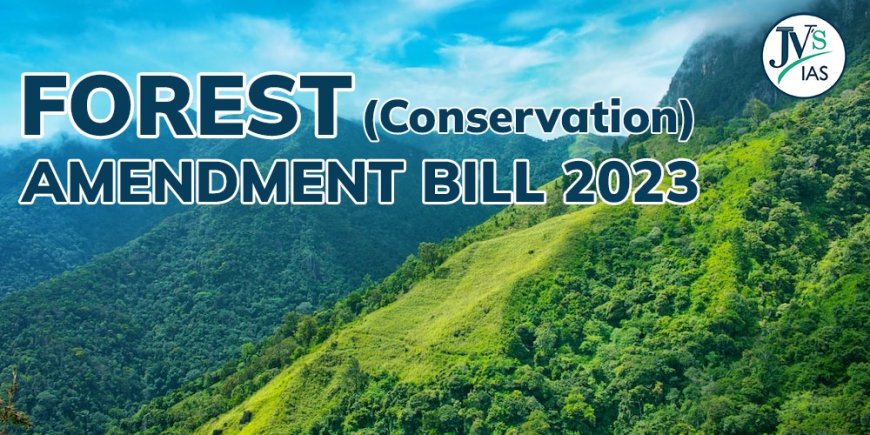Forest (Conservation) Ammentment Bill, 2023
The Forest Conservation Amendment Bill 2023, passed by the Indian Parliament, aims to enhance sustainable development while ensuring tribal communities' access to basic amenities. Key changes include renaming the Forest Conservation Act of 1980 and limiting its applicability to lands designated as forests under the Indian Forest Act 1927. The bill introduces provisions for development projects, new forestry activities, and empowers local communities through initiatives like ecotourism. However, controversy surrounds the bill's restrictions on forest conservation, leading to concerns about the potential impact on India's forested areas. Despite criticisms, proponents highlight the bill's potential benefits, including climate change mitigation and livelihood opportunities for forest-dependent communities.

INTRODUCTION
The Forest Conservation Amendment Bill 2023 was passed by the Indian Parliament on August 2 to enhance India's commitment to sustainable and inclusive development. The Forest Conservation Act of 1980 now includes these amendments, which are crucial in regulating the diversion of forest land for non-forestry purposes with a vision to ensure that tribal people have access to basic communities that enhance their is of living.
What is the Background?
Following Independence, large expanses of forested lands were officially designated and marked as reserved and protected forests. Despite this, a large number of forested areas were omitted, and areas with no standing forests were included in 'forest' lands. In the Godavarman case, 1996, the Supreme Court suspended the felling of trees across the country and ruled that the FC Act would apply to all land parcels that were either recorded as 'forest' or resembled the dictionary meaning of forest. The Forest Conservation Rules were modified by the government in June 2022 to propose a method for developers to plant trees on land on which the (FC) Act is not applicable" and to swap such plots against subsequent requirements of compensatory afforestation.
Major changes introduced by the Forest Conservation Amendment Bill, of 2023
1. The amendment to the Forest Conservation Act includes changing the name to Van (Sanrakshan Evam Samvardhan) Adhiniyam, 1982, to ensure that the potential of its provisions is reflected in its name, clarifying the scope of applicability of the act in various lands to eliminate ambiguities.
2. The Forest Conservation Act of 1980 is being applied to land that has been designated as a forest under the Indian Forest Act 1927. The act will not be applicable for land converted to non-forest use before December 12, 1996
3. It also exempts certain types of land from the purview of the act. These include land within 100 km of India's border, which is needed for national security projects, small roadside amenities, and public roads, leading to habitation.
4. To assign new forest land to a private entity, the state government must receive prior approval from the central government. The bill expands this to all entities and authorizes the central government to specify the terms and conditions for the assignment.
How does the Bill restrict the scope of the Act?
The Bill's primary aim is to redefine the definition of a 'forest' in Indian law. It stipulates that only those lands that have been notified as 'forests' under the Act as well.
This revision is a stark contrast to the current Act's wide applicability, which applies to all forest lands. A Supreme Court judgment in 1996 reiterated such a broad application. In his speech, he mentioned that a 'forest' encompasses all land recorded as such in government records, regardless of ownership, and 'deemed forests', Despite not being classified as 'forests', they meet the dictionary definition of 'any large area with significant tree cover and undergrowth'. About 40% of the Aravalli range and 95% of the Niyamgiri hill range are areas that are expected to be significantly impacted. the latter is home to the Dongria Kondh, a Particularly Vulnerable Tribal Group.
Many experts are uncertain and apprehensive about the extent of land that will fall outside the purview of the amended act considering the State-wise data of deemed forests is not publicly available.
Key Provisions of the Forest (Conservation) Amendment Bill 2023
▪ Provisions for Development:
- The Bill extends existing provisions of the Principal Act relating to the assignment of forest land, on lease to private entities, to Government companies as well.
- This will facilitate development projects and ensure uniformity in the implementation of the Act.
▪ New Forestry Activities:
The amendments include new forestry activities like infrastructure for frontline forest staff, ecotourism, zoo, and safari. Surveys and investigations in forest areas will not be considered non-forestry activities.
▪ Climate Change Mitigation and Conservation:
It aims to ensure that such areas contribute to India's efforts in combating climate change by being recognized as part of its forest conservation efforts and contribute to India’s international commitments like Net Zero Emission by 2070.
▪ Empowering Local Communities:
- Activities like setting up zoos, safaris, and ecotourism are encouraged by the bill, which will be owned by the government and established in approved plans outside Protected Areas.
- These activities not only raise awareness about forest conservation and wildlife protection but also create livelihood opportunities for local communities, integrating them with overall development.
Why is it controversial?
The conservation of woods and forests is strictly restricted to those that have been notified and recorded in official records on or after October 25, 1980. The law exempts forest lands that were converted to non-forest purposes before the Godavarman judgment on December 12, 1996. This means that 28% of India's forests will automatically lose their protection since they are located outside registered Forest Areas (RFAs), which are defined by the Forest Survey of India (FSI) as all areas registered by the government.
Conclusion
The Forest Conservation Amendment Act (FCAA) 2023 is the exact opposite of what it is supposed to protect and promote: it prioritizes development over forest conservation. The changes mentioned herein have been included in the Amending Act. While there have been drawbacks to this, there are many more advantages, such as combating climate change, achieving good and favorable tree cover, reducing emissions, improving livelihood of the forest-dependent people, and earning money through safaris and ecotourism facilities.











































